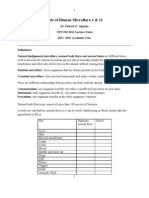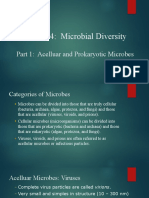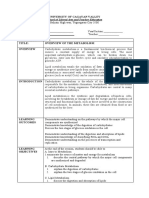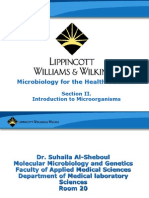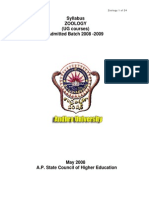Microbial Diversity
Microbial Diversity
Uploaded by
Arun SendhilCopyright:
Available Formats
Microbial Diversity
Microbial Diversity
Uploaded by
Arun SendhilOriginal Description:
Copyright
Available Formats
Share this document
Did you find this document useful?
Is this content inappropriate?
Copyright:
Available Formats
Microbial Diversity
Microbial Diversity
Uploaded by
Arun SendhilCopyright:
Available Formats
MICROBIAL DIVERSITY
INTRODUCTION Microorganisms have developed the basic types of metabolism and a wide range of activities, which allowed them to colonize all ecosystems and create the biosphere. As they are also the movers and shakers of global cycles of elements, they significantly contribute for stability and proper functioning of ecosystems that are threatened by man-made disturbances. The species richness, species evenness and species difference describe biodiversity. It is now being used synonymously with the word ecodiversity !einbauer and !eneroth, "##"$. The diverse species of microorganisms constitute the microbial diversity as species richness in a given habitat be it on land, in fresh water or sea or as parasites or symbionts. Microorganisms e%hibit e%traordinary genetic and phenetic diversity. &espite their importance, less than '( of the world)s microorganisms have been described. *f the +##,### to one million species of prokaryotes on earth only +,,## bacteria have been described in the -ergey )s Manual of the .y s temat i c -ac ter iology. The omnipresence of microgranisms through the biosphere is a cose/uense of their ready dissemination by wind and water. .urface waters, the floors of oceans over the continental shelves and the top few inches of soil are teeming with microorganisms that are ready to decompose organic matter that may become available to them. The abundance of prokaryotes in open ocean, in soil and in oceanic and terrestrial subsurfaces is ,." % ,#"0, ".1 % ,#"0, +.' ,#+# and #."'-".' % ,#+# respectively. Among the deep-sea microflora appro%imately one third of the prokaryotes are Archaea 2arner et al, "##,$. The estimated number of viruses in the world oceans is appro%imately 3.' % ,#"0 while no total virus number are known from soil and subsurface . The top 1 inches of fertile soil contains more than " tons of fungal and bacterial biomass. It has been estimated that there might be up to ,#,### bacterial species per ,## g soil . A handful of soil contains different kinds of microbes4 even a single soil particle represents ecological niches for different types to develop 5ee, "##"4 .teage and 6aft, "##"4 Morin, "###$. Thus the prokaryotes have been described correctly as the unseen ma7ority !hitman et al, ,008$ and this is more correct for all microbes. The microorganisms are of central importance on account of the following 9 they represent e%perimental systems with the strategies and e%treme limits of life 9 they are of critical importance in sustainability of life forms on earth 9 untapped microbial diversity is a resource for new genes and organisms of value to biotechnology, 9 microbial diversity pat terns of mi c r obes can be used for moni tor ing and predicting environmental changes 9 they help in conservation and restoration of the higher organisms 9 microbial communities are e%cellent models for understanding biological interactions and evolutionary history CONSERVATION OF MICROBIAL DIVERSITY The problem of biodiversity is essentially one of conflict resolution between the human kind on one side and living organisms inhabiting different environment on other side. The :5;<& :nited 5ations ;onference on <nvironment and &evelopment$ process has helped place the loss of biodiversity and it)s conservation on global agenda. The ;onvention on -iological &iversity ;-&$ that emerged from the :5;<& or <arth .ummit at =io de >anerio in >une ,00" is now a treaty. According to the !orld ;onservation Monitoring ;enter, ,,1#?,### species have been described at the golbal level. India accounts for 8( of global biodiversity e%isting in only ".?( land area of the world 2hoshoo ,0014 @arley and .cot ,000$. Microbial diversity conservation re/uires certain specialized techni/ues for applications in reclaiming a degraded habitat. -oth e% situ and in situ techni/ues can be employed to preserve the biodiversity. Ex-situ Preservation
The most effective and efficient mechanism for conserving biodiversity is to prevent the destruction or degradation of the habitat. -ecause of the uncertainties associated with in-situ conservation of microorganisms, e%-situ preservation plays a ma7or role in microbiology and include the gene banks, culture collections and microbial resource centers ;olwell ,003$ forming the respository for microbial isolates and do away with need for costly and time consuming re-isolation protocols . The ;-& encourages adoption of measures for e%situ conservation of biodiversity, preferably in the country of origin. Application of this approach is supported by the !orld Aederation for ;ulture ;ollection !A;;$ and &irectory of ;ollection of ;ultures of Microorganisms. Moreover four other associations that directed towards this effort are *ceanic and Atmospheric Administration for marine microbial diversity, 5ational Institute of Bealth for deciphering the emerging microbial pathogen diversity, American .ociety for Microbiology and American Chytopathological .ociety . In India this work has been carried out by Ministry of <nvironment and Aorestry and the Ministry of .cience and Technology that includes various departments such as the &epartment of Agriculture =esearch and <ducation, Indian ;ouncil of Aorestry =esearch and <ducation, &epartment of -iotechnology. The level of the Microbial Type ;ulture ;ollection section of IMT<;B, ;handigarh has now been upgraded to an International &epository Authority I&A$ and it involves the culture collection and maintenance as well as distribution of pure cultures internationally. The e%-situ collections of microorganisms form the key respositories of biodiversity and an essential resource for the future as these could be linked to the research programs and developmental aspects of the country that owns it by integrating the microbiological aspects, molecular evolution, systematics and microbial chemistry with genome science. <nhanced funding of stock centers and greater emphasis on education and research in microbial systematics will amplify the broad base of research into microbial diversity. In-situ Conservation -asically, in-situ preservation involves on site conservation of the microbial flora involving the conservation of the ecosystems and natural habitats and the maintenance as well as recovery of viable populations of species in their natural surroundings and in case of the domesticated or cultivated species, in surroundings where they have developed their distinctive properties. ;onservation of all subsets of life e%isting in interplaying networks will lead to preservation of microbes as well. Avoiding deforestation and planting trees Aforestation$ will not led the surface soil to be washed out by torrential rains, which contains diverse microflora. Aurther, avoiding pollution of water bodies such as oceans, river or lakes will preserve phytoplanktons, zooplanktons rotiferans, microalgae, diatoms, dinoflagellates$ and other floating microbes such as @ibrio parahaemolyticus, -acillus sp, .pirillum sp., A/uaspirillum sp. and others. ;ertain countries such as Italy, ;anada, -razil, Me%ico, ;hile, Argentina, are facing new kind of natural conservation on account of widespread 7ungle fires. Microbial diversity in forest soils is a key factor in ecosystem function. .taddon et al ,001$ have described the role of fire and its impact on conservation of microbial diversity of forest soil. Darge-scale endemic fires in Andes Mountain ranges increased the carbon content besides considerable increase in phosphorus, calcium, zinc and other trace elements. This contributed towards increase in number and variety of microorganisms in soil after second or third rains. 5ational -iodiversity ;onservation -oard has taken interest in microbial diversity and its preservation. UTILITY OF MICROBIAL DIVERSITY Microbial diversity e%isting in natural ecosystems has the following ma7or applications4 !" Bio#eo$%e&i$a' ro'e in $($'in# o) &atter .oil acts as the source of nutrition for the growth of a spectrum of microorganisms which have remarkable ability to degrade a vast variety of comple% organic compounds due to their metabolic versatility Erime, ,003$. Microbes carry
out recyling of phosphorus, o%ygen, carbon, nitrogen and sulphur elements and replenish the environment with these by degrading substrates obtained from dead and decaying plant and animal remains. Baack et al ,00'$ have analyzed various factors that affected the accuracy, reproducibility and interpretation of carbon source utilization patterns of microbial communities The replenishment is essential on account of reuse of vital elements and hence microbes work as efficient decomposers and scavengers to clean up the biosphere Maire et al, ,003$. *" Sustaina+'e 'an, use Microorganisms play a key role in soil fertility including its maintenance They can act as indicators for assessment of sustainable land use in space and time. A combination and improvement of several concepts of sustainability may help obtain an integrated signal of functional ecophysiology of microbiota &illy and -lume, ,008$. Buman encroachments and disturbances such as addition of pesticides affect the microbial components of an ecological niche Magu, ,008$ and thus a simultaneous effect is observed on biotransformation reaction occurring in soil. Ma7or processes as sulphur o%idation, nitrification and nitrogen fi%ation are inhibited by pesticide application =amakrishan and .ethunathan, ,008$. =e/uena ,003$ has discussed the role of the mycorrhizal symbiosis in restoration of degraded semiarid and other ecosystems. Eadd ,00+$ reviewed the metal tolerance of @AM fungi at heavy metal contaminated sites. Darge effects of mycorrhizae as in increasing accumulation of ;u, 5i, Cb, and 6n in grass <hrhartia calycina have been found, especially at low soil pB 2ilhan and Airestone, ,08+$. Arsenate tolerance in plants appears to depend on modifications to the C transport system and the root absorbing capacity. The tolerant genotypes of plant were found to depend on @AM fungi for C uptake and conse/uent success Mehrag, ,00?$. Moreover mycorrhizal fungi connect individuals of same or different plant species, enabling direct interactions between the members of a grassland or forest community !iemken and -oller, "##"4 ;opley, "###$ and conse/uently mycorrhizal fungal diversity determines plant diversity, ecosystem variability and productivity. -" Mi$ro+ia' .ro,u$ts )or a#ri$u'ture .ur.oses Modern agriculture depends upon heavy input of chemical fertilizers that are produced by using non-renewable and constantly depleting petroleum based feed stocks. The diversity of soil microbial communities can be key to the capacity of soils to suppress soil-borne plant diseases 2ennedy and .mith, ,00'4 @an <lsas et al, "##"$. The health of soil can be defined in terms of its microbiological capacity to suppress the activity of plant pathogenic microbes which could be general owing to aseptic activities of a myriad of undefined organisms or specific suppressiveness due to antagonism @an -ruggen and .emenov, "###$ =aai7makers and !eller ,008$ reported the concomitant increase in the population of fluorescent pseudomonads that produce antifungal antibiotic ",?-diacetyl phloroglucinol &ACE$ in wheat monocropping system and thus specific, suppressiveness of take-all disease in wheat that increased the yield. =ecently in India, &ACE production by C. fluorescens was reported to suppress rice bacterial blight @elusamy and Enanamanickam, "##+$. 2umar ,00#$ has reported in vitro antibiosis of three fluorescent pseudomonads isolated from rhizosphereFrhizoplane of crop plants against 3 fungal and " bacterial plant pathogens and thus e%hibited the role in disease suppression and crop
improvement. Bence, rhizosphere bacteria could be used as biocontrol agents for plant diseases Cal and >alai, ,008$. 2ennedy ,000$ isolated specific rhizobacteria and reported the management of weeds by these soil bacteria. /" Bio,e#ra,ation o) 0eno+ioti$s Buman kind is increasingly using pesticides as -B;, &&T, ",?-&,",?,'-T for getting rid of unwanted weeds, insect pests or pathogenic microorganisms. =emoving chemical from the environment can be achieved by ease and in environment-friendly manner by biological methods that involve use of microbes and plants to degrade a %enobiotic compound and thus decontamination of the polluted site -ioremediation$ or purification of hazardous wastes in water -iotreatment$. -iological treatments are more effective as these methods convert to%ic chemicals to less to%ic ones and possess a significant degree of self-regulation. Microorganisms have diverse capacities to biotransform and, in some cases, to completely destroy to%ic chemicals in our environment. .ince these transformations alter the chemistry of the hazardous chemical, they may also alter to%icity, environmental fate, and bioaccumulation potential. .everal halogenated chemicals such as the chlorinated aromatic compounds, which are ma7or contaminants, nitroaromatics and other con7ugated hydrocarbons-polluted contaminated sites could be reclaimed by use of the vanguard organisms isolated from contaminated sites by enrichment cultures .pain, ,00'4 ;oates et al, ,003$. .pingomonas paucimobilis -C.I-+ that was isolated from C;- contaminated soil was observed to degrade halogenated CABs and biphenyls &avison et al, ,000$. Bead G .wannell ,000$ reported bioremediation of petroleum hydrocarbon contaminates in marine habitats by anaerobic hydrocarbon metabolism via bioaugmentation and stressed to re7ect the approach of nutrient amendment as it can potentially e%ert as o%ygen demand due to biological ammonia o%idation. 1" A..'i$ations in In,ustr( -iotechnology has a practical definition that Hit is application of power of micorbe)s biosynthetic capabilities to manufacture high-value products that are too comple% for chemical synthesis by economically viable processes, resulting in value addition and financial gainsI. .oil microorganisms have been the most valuable source of natural products, providing industrially important antibiotics and biocatalysts. The development of novel cultivation-dependent and molecular cultivation-independent approaches have paved the way for a new era of product recovery from soul microorganisms. In particular, gene-mining based on the construction and screening of comple% libraries derived from the soil metagenome provides opportunities to fully e%plore and e%ploit the enormous genetic and metabolic diversity of soil microorganisms which has resulted in isolation of novel biocatalysts and bioactive molecules including biocatalysts of industrial interest such as amylases, lipases, proteases, dehyratases, o%idoreductases and agarases =olfe, "##?$. =ichardson et al "##"$ described a high performance amylase for starch li/uefaction that was generated by combining environmental discovery evolution for the identification and optimization of the enzyme. Many microbes are e%tracted from soil and used in industrial production of various kinds as food processing and production, development of biocides, biocontrol agents, medicines.
You might also like
- Metals & Non-MetalsDocument16 pagesMetals & Non-Metalseditsnaruto106100% (13)
- Brock Microbiology 13 Lecture PresentationDocument80 pagesBrock Microbiology 13 Lecture PresentationFatma SagirNo ratings yet
- Chapter 6Document22 pagesChapter 6Marlop CasicasNo ratings yet
- CHAPTER 1 Microbial World and YouDocument4 pagesCHAPTER 1 Microbial World and YouAsther MantuaNo ratings yet
- Hw3ans 1Document5 pagesHw3ans 1Abdisalaam mohamud100% (1)
- Chapter 7 Microbial Physiology and GeneticsDocument47 pagesChapter 7 Microbial Physiology and GeneticsJhane Kimberly A. RustiaNo ratings yet
- Controlling Micriobial GrowthDocument47 pagesControlling Micriobial GrowthasiNo ratings yet
- Chapter 6: Microbial Growth: Learning Objectives Check Your UnderstandingDocument5 pagesChapter 6: Microbial Growth: Learning Objectives Check Your UnderstandingMd SagorNo ratings yet
- Microorganisms: Clasiffication ofDocument38 pagesMicroorganisms: Clasiffication ofGOWTHAM GUPTHANo ratings yet
- Microbiology For The Health Sciences: Chapter 2. MicrosDocument23 pagesMicrobiology For The Health Sciences: Chapter 2. MicrosHashim Ghazo100% (1)
- Introduction To MicrobiologyDocument55 pagesIntroduction To MicrobiologyAngelica Valdez BalmesNo ratings yet
- Principles of Diagnostic Medical MicrobiologyDocument4 pagesPrinciples of Diagnostic Medical MicrobiologyTarequl Islam NishadNo ratings yet
- Normal Body Flora - Beneficial EffectsDocument10 pagesNormal Body Flora - Beneficial EffectsVitrana SankarNo ratings yet
- Biochem IntroDocument6 pagesBiochem IntroAlliah CasingNo ratings yet
- Microbial DiversityDocument6 pagesMicrobial DiversityDev AnandhNo ratings yet
- Bacteria (Unit I)Document22 pagesBacteria (Unit I)Muhammad KaleemNo ratings yet
- Chapter 4: Microbial Diversity: Part 1: Acelluar and Prokaryotic MicrobesDocument48 pagesChapter 4: Microbial Diversity: Part 1: Acelluar and Prokaryotic MicrobesMudarab AliNo ratings yet
- Lecture 2 Microbial Growth and NutritionDocument35 pagesLecture 2 Microbial Growth and NutritionMaria Florida ClementeNo ratings yet
- Inflammation Basic KnowledgeDocument35 pagesInflammation Basic KnowledgeAsma AliNo ratings yet
- Control of Microbial GrowthDocument35 pagesControl of Microbial GrowthVincent ManganaanNo ratings yet
- Microbial NutritionDocument24 pagesMicrobial NutritionDeepak MudaraddiNo ratings yet
- 1 History and Scope of MicrobiologyDocument5 pages1 History and Scope of MicrobiologyAlphonse Rossaint SambranoNo ratings yet
- Chapter 7, 10, 11, 12, 13Document18 pagesChapter 7, 10, 11, 12, 13Claudia Keith McBroom43% (7)
- Laboratory Exercise 4. Microscopic Observation of MicroorganismsDocument9 pagesLaboratory Exercise 4. Microscopic Observation of MicroorganismsNesly Joy CaballeganNo ratings yet
- MODULE - FINALS - Biochem - 1Document5 pagesMODULE - FINALS - Biochem - 1Cyril CauilanNo ratings yet
- Study of ParameciumDocument22 pagesStudy of ParameciumDon DasNo ratings yet
- Organic Molecules.Document9 pagesOrganic Molecules.Aimal SafdarNo ratings yet
- Botany Notes 101Document7 pagesBotany Notes 101Ma. Lilian Jem MonteroNo ratings yet
- Book On Microbiology Laboratory PDFDocument85 pagesBook On Microbiology Laboratory PDFvsvsuresh2099100% (2)
- Endospore Stain QuestionsDocument7 pagesEndospore Stain Questionslizyan1100% (1)
- Morpholofy of MoDocument44 pagesMorpholofy of MoPathumavathy RamanathanNo ratings yet
- Week 1 Historical Development, Divisions of Microbiology, and Taxonomy-1Document52 pagesWeek 1 Historical Development, Divisions of Microbiology, and Taxonomy-1Hayzan Faith PuyaoNo ratings yet
- Prelims Micropara LecDocument14 pagesPrelims Micropara LecBSN1F- JACILDO, KUH KYLA C.No ratings yet
- Module 1 - PSTMLSDocument53 pagesModule 1 - PSTMLSArvie Karl NabiNo ratings yet
- Chapter 6 The Biochemical Basis of LifeDocument54 pagesChapter 6 The Biochemical Basis of LifeJhane Kimberly A. Rustia100% (1)
- Scope of MicrobiologyDocument9 pagesScope of MicrobiologyrachnnaaNo ratings yet
- Enumeration of Microorganisms: Microbiology BIOL 275Document10 pagesEnumeration of Microorganisms: Microbiology BIOL 275Diya GhosalNo ratings yet
- NURSING ANAPHY Lec Session #12 - SAS (NEW FORMAT) PDFDocument2 pagesNURSING ANAPHY Lec Session #12 - SAS (NEW FORMAT) PDFKriztel Andrei Lapac NavajaNo ratings yet
- SerialDilutions PDFDocument5 pagesSerialDilutions PDFAmelia_KharismayantiNo ratings yet
- Discuss The Various Theories On The Gram Stain.: Gram-Negative Bacteria Gram-Positive BacteriaDocument5 pagesDiscuss The Various Theories On The Gram Stain.: Gram-Negative Bacteria Gram-Positive BacteriaFiddo Waggay100% (3)
- Micropara Lec Unit 1 LaDocument1 pageMicropara Lec Unit 1 LaGrace HernandezNo ratings yet
- 7 Motility Determination by Hanging Drop TechniqueDocument5 pages7 Motility Determination by Hanging Drop TechniqueGaurav MudaduNo ratings yet
- Herbal Medicine Preparation (Decoction) : Preparation Rationale C X N RDocument3 pagesHerbal Medicine Preparation (Decoction) : Preparation Rationale C X N RLalynne G. MedinaNo ratings yet
- Controlling Microbial Growth in VitroDocument5 pagesControlling Microbial Growth in VitroLady DanielleNo ratings yet
- Biochemistry: DR - Radhwan M. Asal Bsc. Pharmacy MSC, PHD Clinical BiochemistryDocument13 pagesBiochemistry: DR - Radhwan M. Asal Bsc. Pharmacy MSC, PHD Clinical BiochemistryAnas SeghayerNo ratings yet
- 1microbiology PRELIM-merged PDFDocument134 pages1microbiology PRELIM-merged PDFHelping HandsNo ratings yet
- ImmunityDocument44 pagesImmunityHam Za100% (2)
- Microbiology For The Health Sciences: Section II. Introduction To MicroorganismsDocument48 pagesMicrobiology For The Health Sciences: Section II. Introduction To MicroorganismsHashim Ghazo100% (1)
- ZoologyDocument24 pagesZoologyS V S VardhanNo ratings yet
- Biological ScienceDocument6 pagesBiological ScienceMae Quibod PerezNo ratings yet
- Plant Cells Structure of The Plant CellsDocument10 pagesPlant Cells Structure of The Plant Cellsstudent10100No ratings yet
- Introduction To Human AnatomyDocument50 pagesIntroduction To Human AnatomyStephanie AsamaNo ratings yet
- Physiology of BacteriaDocument150 pagesPhysiology of BacteriaМохіт Кумар Ямпаті100% (1)
- Case Presentation 9Document51 pagesCase Presentation 9Evelyn MedinaNo ratings yet
- Capsule, Flagella, Pili, EndosporesDocument21 pagesCapsule, Flagella, Pili, EndosporesabimubNo ratings yet
- Bacterial Virulence FactorsDocument4 pagesBacterial Virulence FactorsYasmin NimsayNo ratings yet
- Chapter 1 MicroparaDocument3 pagesChapter 1 MicroparaJun Elbert JaboliNo ratings yet
- Importance of BiochemistryDocument5 pagesImportance of BiochemistryDICKSONNo ratings yet
- Introduction To The Immune SystemDocument21 pagesIntroduction To The Immune SystemDiandra DwitavianyNo ratings yet
- The politics of hunger: Protest, poverty and policy in England, <i>c.</i> 1750–<i>c.</i> 1840From EverandThe politics of hunger: Protest, poverty and policy in England, <i>c.</i> 1750–<i>c.</i> 1840No ratings yet
- Taxonomy Journal ProjectDocument7 pagesTaxonomy Journal Projectanupama_rani_2No ratings yet
- The Living Interface:: Soil and Water Conservation Vis-À-Vis Soilborne MicrobesDocument20 pagesThe Living Interface:: Soil and Water Conservation Vis-À-Vis Soilborne Microbesapi-310125081No ratings yet
- Problem Set 1 NewDocument2 pagesProblem Set 1 Newgm_navyNo ratings yet
- Rec It 16 With SolutionsDocument2 pagesRec It 16 With SolutionsReeseNo ratings yet
- Refrigeration and Air ConditioningDocument23 pagesRefrigeration and Air ConditioningSAIKATNo ratings yet
- Chemsheets As 1001 Atomic StructureDocument1 pageChemsheets As 1001 Atomic StructurejnfjngsdjNo ratings yet
- FluidizationDocument3 pagesFluidizationUmairAhmedNo ratings yet
- Geology For Civil Engineers Reviewer Week 7Document7 pagesGeology For Civil Engineers Reviewer Week 7Rhea PardiñasNo ratings yet
- Merseyside: Health & Safety Executive ST Annes House Stanley Precinct Bootle, L20Document1 pageMerseyside: Health & Safety Executive ST Annes House Stanley Precinct Bootle, L20Franco Zeffirelli ArochaNo ratings yet
- GROUP 1 - Cycles of MatterDocument7 pagesGROUP 1 - Cycles of MatterMary Ylane LeeNo ratings yet
- Introduction Project GeotechnicsDocument1 pageIntroduction Project GeotechnicsAfif AzharNo ratings yet
- Unit Iii: Inter-Relationship Between Disasters AND DevelopmentDocument19 pagesUnit Iii: Inter-Relationship Between Disasters AND DevelopmentTina TruemanNo ratings yet
- Periodic TrendsDocument19 pagesPeriodic TrendsEzra ChuaNo ratings yet
- IB - Regal Hydro V2Document6 pagesIB - Regal Hydro V2Arun NatarajanNo ratings yet
- GEYA Solar Product Catalog - 1Document50 pagesGEYA Solar Product Catalog - 1alfonso muroNo ratings yet
- GreenCityWatch UserGuide IndonesiaDocument24 pagesGreenCityWatch UserGuide IndonesiaAchmad SyafiiNo ratings yet
- Oral TestDocument2 pagesOral Testholaifong33% (3)
- CHE3003 Mass Transfer Mass Transfer CHE3003 Mass Transfer - I Mass Transfer - IDocument20 pagesCHE3003 Mass Transfer Mass Transfer CHE3003 Mass Transfer - I Mass Transfer - IermiasNo ratings yet
- Eca MicroprojectDocument12 pagesEca Microprojecthemantkshirsagar2309No ratings yet
- 0625 Thermal Properties and Temperature - P4 - QP2Document20 pages0625 Thermal Properties and Temperature - P4 - QP2apdrenlNo ratings yet
- ch05 PDFDocument149 pagesch05 PDFLowell PalacpacNo ratings yet
- 05 02 Evolutionary RelationshipsDocument4 pages05 02 Evolutionary RelationshipsIsra ImrozNo ratings yet
- Trays and Packings Used in Distillation and Gas AbsorptionDocument12 pagesTrays and Packings Used in Distillation and Gas AbsorptionRhea Mamba100% (1)
- Letter of MotivationDocument1 pageLetter of MotivationPùtRèé MèîNàá DêVìèé100% (1)
- Question 5 and 6Document7 pagesQuestion 5 and 6tony frank100% (1)
- Practical Research Part2 FINALE 1 1Document32 pagesPractical Research Part2 FINALE 1 1Hzm MataoNo ratings yet
- NNSE618 L8 Transport PhenomenologyDocument11 pagesNNSE618 L8 Transport PhenomenologyBayanjargal ErdeneeNo ratings yet
- Fluid Dynamics PDFDocument11 pagesFluid Dynamics PDFrgcsm88100% (1)
- Silent Spring ReflectionDocument2 pagesSilent Spring ReflectionMarianie Vidal VicenteNo ratings yet
- Flame Photo Meter 07012017Document27 pagesFlame Photo Meter 07012017pankajNo ratings yet












